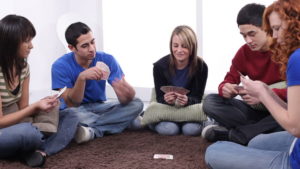I had been on my feet for hours. I woke up with the sun, lugged the rest of my gear to the room where our event was held, and had the morning running back and forth to ensure that everything was running as smoothly as we could make them. I had just come off of teaching and playing a three hour game of Scythe with six other people who had never played before – guiding them through a game I had only played once before myself. When the game was packed away, a friend who had also been part of the game stood up beside me. “I don’t know about you,” he said, “But I kinda need a rest after that. Wanna play something light?” Honestly, I wasn’t sure I wanted to play anything. I needed to get back to running the show. But, ever open for a chance to share time at a table, I decided something small would work well. We picked up Onitamaand laid it out on the table.

Technically we were still playing. There was a game in front of us and moves were being made. Onitama, however, is a game that is as thoughtful as you want it to be, and we were hardly playing like grand masters. We were mostly just chatting with a game in front of us. He brought up a sign he saw hanging in the hallway. The sign read “Immersion Chamber,” and it featured a logo of swirling water and font that was reminiscent of a metal band logo. Oddly enough, it was a logo I had designed when I worked with the youth ministry at the church. “I gotta ask. What happens in the ‘immersion chamber?’”
“It’s just the room where the youth group meets. The group is called ‘Immersion.’ Churches do that. They name their groups one or two word phrases – often allusions to water or fire. Don’t ask me why.” I moved my piece.
“Huh. Well I’ll take your word for it. I’d normally never come to a place like this. So I hardly get an inside view. This isn’t the kind of place I’d think of when I think of church.” So we started talking about church. What it looks like and what it feels like. The whole conversation lasted about ten minutes or so, but it was also a moment where a door creaked open. An understanding that there is no one catch all for what church looks like snuck in.
When planning the structure of your gaming event, there may be a temptation to fill every minute and every table with games. Always moving. Always teaching. Throw as many experiences at folks as you can and see what sticks. The danger, though, is that constant activity doesn’t allow for anything that isn’t tied directly to a game. It doesn’t give space for people to get to actually know each other. We may have never had that simple discussion about how the room down the hall isn’t where we keep the pool if there wasn’t space for it. We have some suggestions for ways to create this sort of space at your gaming events.
Light Doesn’t Equal Bad
 Onitama was our game of choice that day, but there is no shortage of games that are fun but still light enough that they don’t require players to be face down in their cards planning strategies. People have been talking over card games for generations. Having a deck of everyday playing cards available for a relaxing game of Hearts, Sevens, or what have you that people can talk across. There are also games like Diamonds that build off of those classics. Titles like Smash Up, Nyet, or No Thanks are all based on a series of simple choices. That simplicity provides an environment where people at the table are engaged, yet still feel free to converse.
Onitama was our game of choice that day, but there is no shortage of games that are fun but still light enough that they don’t require players to be face down in their cards planning strategies. People have been talking over card games for generations. Having a deck of everyday playing cards available for a relaxing game of Hearts, Sevens, or what have you that people can talk across. There are also games like Diamonds that build off of those classics. Titles like Smash Up, Nyet, or No Thanks are all based on a series of simple choices. That simplicity provides an environment where people at the table are engaged, yet still feel free to converse.
Free Space
It’s important to let people feel comfortable at your event – so cordoning off a section of your room just as a non-gaming area so that people can relax between plays is actually counter productive. In our experience, saying “This is the place where only this thing happens” often means no one uses it. Instead – use the space to suggest conversations and time away from the games rather than naming it. Create a space that lends itself more to socializing than gaming for people to step away for a moment without feeling awkward. Take away the tables and add extra chairs. Depending on what you have available, couches, lounge areas or even a pile of pillows on the floor (if that fits the atmosphere of your event) can work. The fact that you created that space for people means they won’t feel outside of the event being there.
We recognize that this isn’t always easy. You can’t always dictate what the space looks like. The space may be borrowed, you don’t have the resources available, or there are restrictions on what you can move. In these cases, you have to adopt a ‘use what you’ve got’ philosophy. It may come down to leaders sitting with folks without worrying about getting game to table. That way, even if you can’t physically create that space, people will still see that it’s fine to just be there and talking with folks.
If you feed them …
Food is always a touchy subject, so to speak. Greasy fingers and spilled drinks are the stuff of nightmares, as the screams of ruined components cry out in the darkness. However, choosing lighter, handheld foods can minimize those dangers – and provide an easy break from the action. This is especially true between games. Getting up to the food, if your event is large enough that you’ll have someone serving food, provides a chance for connection. But even if you don’t have that sort of luxury, stepping away to eat a sandwich or grab something between games also gives opportunity to get to know people outside of game context.
***
When the event was over, one of the pastors from the church came in. His youngest daughter just graduated, and he was excited about the potential for his free time. We talked about what games were like, the varying styles and themes, and then my friend joined the conversation. At one point I walked away, having to take care of some business or other, and returned to see the two of them – the pastor and the man who felt he had no reason to ever set foot in a church, discussing the last ten years of gaming. They never played a game together, but they were still connecting over the piles of cardboard.




